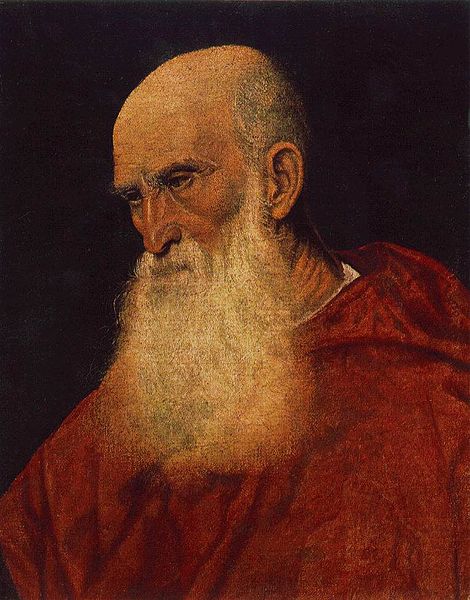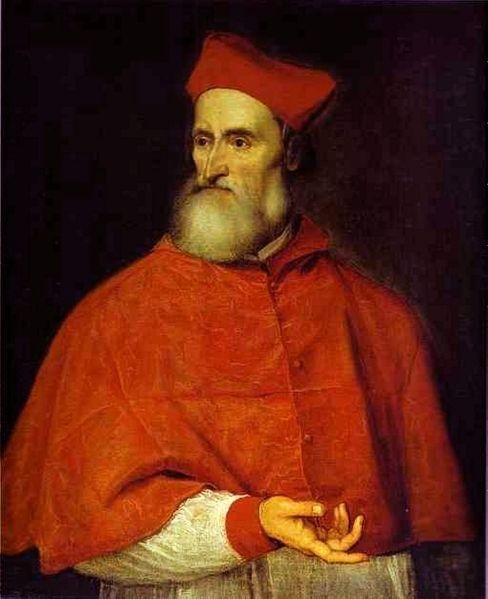<Back to Index>
- Literary Scholar Pietro Bembo, 1470
- Painter Henri - Edmond Cross, 1856
- Spanish Anarchist Diego Abad de Santillán (Sinesio Vaudilio García Fernández), 1897
PAGE SPONSOR


Pietro Bembo (20 May 1470 - either 11 January or 18 January, 1547) was a Venetian scholar, poet, literary theorist, and cardinal. He was an influential figure in the development of the Italian language, specifically Tuscan, as a literary medium, and his writings assisted in the 16th century revival of interest in the works of Petrarch. Bembo's ideas were also decisive in the formation of the most important secular musical form of the 16th century, the madrigal.
Bembo was born in Venice to an aristocratic family. His father was an ambassador for the Venetian state, and while still a boy Pietro was able to accompany him on many of his travels; one of the places he visited was Florence, there acquiring a love for the Tuscan form of Italian, a love which was to prove so important in literary and musical history. He studied Greek for two years under the Greek scholar Lascaris at Messina, and afterwards went to the University of Padua. Further travels included two years (1497 – 1499) spent at the Este court in Ferrara, under the reign of Ercole d'Este I then a significant literary and musical center. While there he met Ariosto and commenced writing his first work, Gli Asolani, a dialogue on the subject of courtly love. The poems in this book were reminiscent of Boccaccio and Petrarch, and were widely set to music in the 16th century. Bembo himself preferred his poetry to be performed by a female singer accompanied by a lute, a wish which was granted to him when he met Isabella d'Este in 1505 and sent her a copy of his book.
In 1502 and 1503 he was again in Ferrara, and had a love affair with the notorious Lucrezia Borgia, who was the wife of Alfonso d'Este. He left around the time of Josquin des Prez's hire by Ercole I d'Este as composer to the chapel, and in time to avoid the plague which decimated the city in 1505, claiming the life of renowned composer Jacob Obrecht.
Between 1506 and 1512 he lived in Urbino, and it was here that Bembo began to write his most influential work, a prose treatise on writing poetry in Italian, Prose della volgar lingua, although it was not to be published until much later. In 1513 Bembo accompanied Giulio de' Medici to Rome, where he was soon after appointed secretary to Leo X. On the pontiff's death in 1521 he retired, with impaired health, to Padua, and there lived for a number of years, during which he continued to write, and in 1525 finally published his famous Prose della volgar lingua. In 1529 he accepted the office of historiographer to Venice, his native city, and shortly afterwards was appointed librarian of St Mark's.
Pope Paul III in
1539 made him a cardinal, and Bembo went back to Rome. While there he
continued to write and revise his earlier work, in addition to studying
theology and classical history; he received as reward the bishoprics of Gubbio and Bergamo. He died in Rome in his 77th year. As a writer, Bembo attempted to restore some of the legendary "affect" that ancient Greek had
on its hearers, but in Tuscan Italian instead. He held as his model,
and as the highest example of poetic expression ever achieved in
Italian, the work of Petrarch and Boccaccio, two 14th century writers
he assisted in bringing back into fashion. In the Prose della volgar lingua, he set Petrarch up as the perfect model, and discussed verse composition in
detail, including rhyme, stress, the sounds of words, balance and
variety. In Bembo's theory, the specific placement of words in a poem,
with strict attention to their consonants and vowels, their rhythm,
their position within lines long and short, could produce emotions
ranging from sweetness and grace to gravity and grief in a listener. This
work was of decisive importance in the development of the Italian
madrigal, the most famous secular musical form of the 16th century, as
it was these poems, carefully constructed (or, in the case of Petrarch,
analyzed) according to Bembo's ideas, that were to be the primary texts
for the music. Other works by Bembo include a History of Venice from 1487 to 1513 (published in 1551), as well as dialogues, poems and essays. His early Gli Asolani explains and recommends Platonic affection, somewhat ironically considering his affair with Lucrezia Borgia, married at the time to his employer. His edition of Petrarch's Italian Poems, published by Aldus in 1501, and the Terzerime, which Aldus published in 1502, were also influential. Printer and composer Andrea Antico, active in Rome, was also influenced by Bembo; the early composers of the Venetian School, such as Adrian Willaert, helped to spread his theories among composers during that period of quick change. Willaert's collection of madrigals, Musica nova, show a close connection with Bembo's ideas. The typeface Bembo is named after him.